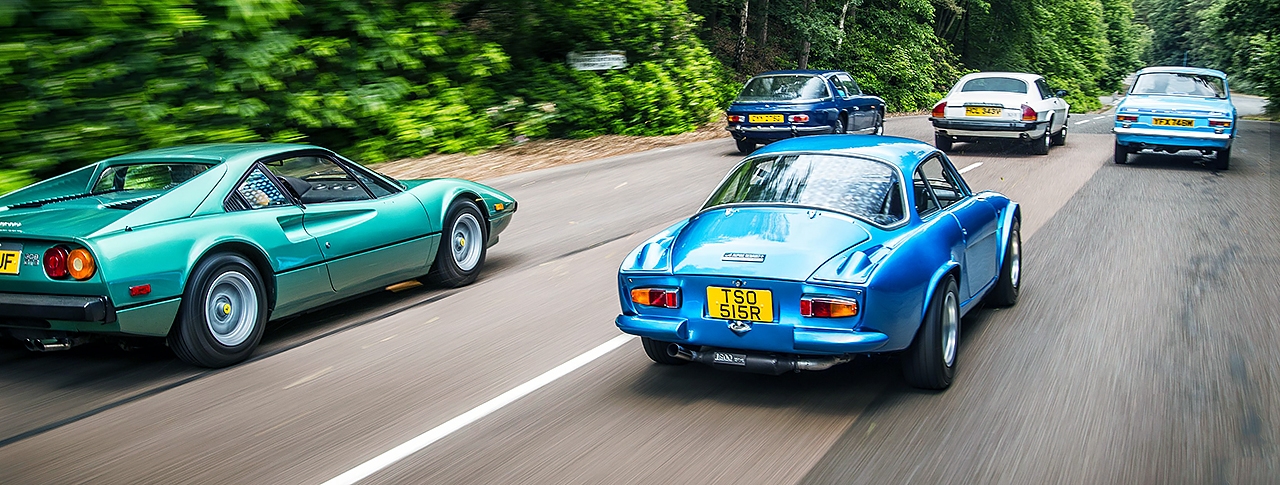
The Hot 30 Five market experts reveal the classics they believe are set to rise in value, from the Jaguar XJ-S, Ford Escort RS2000 MkI and Jensen Interceptor, to the Renault Alpine A110 and Ferrari 308 – plus 25 other sizzlers. Take your pick – clockwise from the front: Jaguar XJ-S, Ford Escort RS2000 MkI, Renault Alpine A110, Ferrari 308, Jensen Interceptor MkI. Five experts tip the cars set to rise – sizzlers from £4.5-500k. ‘Each of our experts has tipped six cars across our price categories that still have scope for growth’ With so many classics having multiplied in value, we asked five market experts to pick the next wave of growers. Words Ross Alkureishi. Photography Charlie Magee.
The Hot 30, starring (clockwise from left): Ford Escort RS2000 MkI, Renault Alpine A110, Ferrari 308, Jensen Interceptor, Jaguar XJ-S.
The buzz around the classic car market in recent years has led to many models soaring to unsustainable price levels and stalling. We asked a broad variety of experts to nominate cars across six price points that still have some way to go and will make every drive, or just a trip to your garage, a special event.
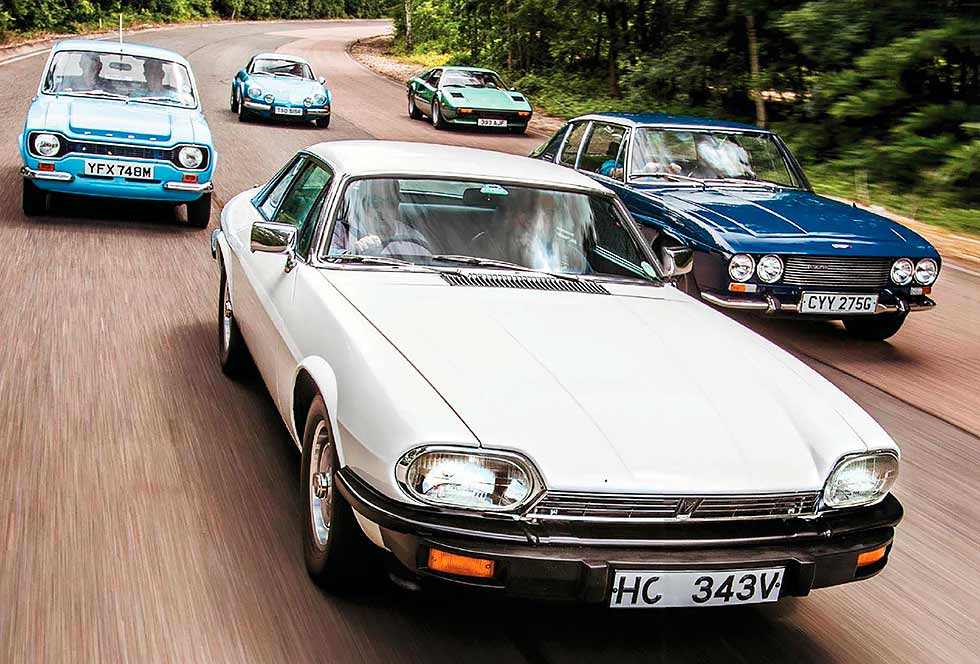
Our five market experts
Iain Tyrrell Managing director, Cheshire Classic Cars, Cheshire.
Will Smith Sales manager, Silverstone Auctions, Warwickshire.
John Mayhead Online content editor, Hagerty Insurance, Northants.
Emanuele Collo Business manager, Kidston SA, Geneva.
James Knight Group director, Bonhams auction house, London.
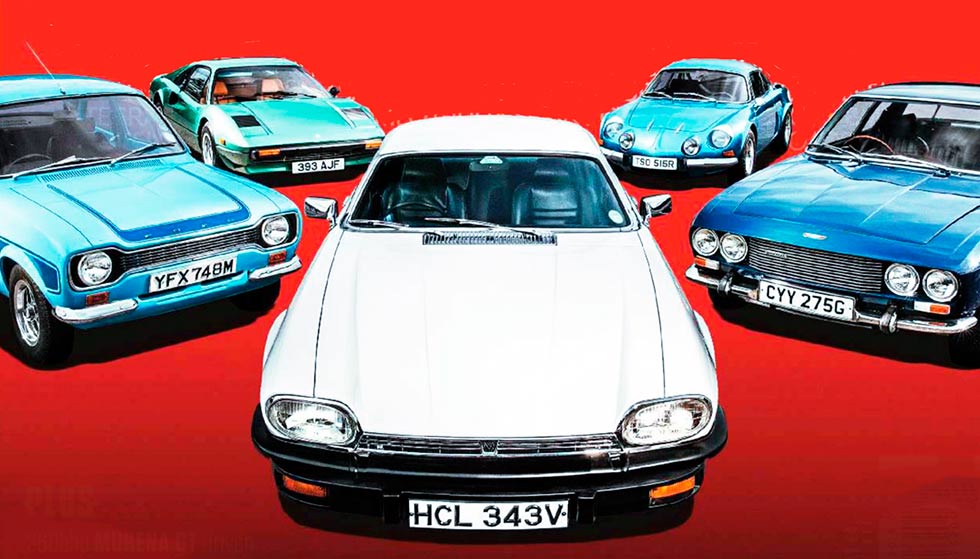
Ford Escort RS2000 MkI vs. Renault Alpine A110 and Ferrari 308 vs. Jensen Interceptor, Jaguar XJ-S plus 25 other sizzlers
Iain Tyrrell, Cheshire Classic Cars
Former Rolls-Royce and Bentley mechanic Tyrell founded Cheshire Classic Cars in 2004. With more than three decades’ experience, he is an authority on all aspects of selling, maintaining and restoring high-end classic road and race cars.
£10,000 Tyrrell’s top choice up to £10k is the Jaguar XJ-S. ‘They had a medallion-man image and lived under the E-type’s shadow for years, but things are changing,’ he says. ‘Go for a Seventies pre-HE car, preferably one of the ultra-rare manuals. Very few have survived because of minimal maintenance expenditure, near-single-figure fuel consumption around town and negligible rustproofing.’
For Charles Porter, owner of the car featured here, his XJ-S could only be one colour – Tudor White. Put that down to the power of television – it’s easy to imagine The Saint star Ian Ogilvy behind the wheel of this example. All that’s missing is the famous ‘ST 1’ numberplate. The long, low and sleek outline has matured well thanks in part to those big almond-shaped eyes. The rubber bumpers may look a bit oversized today but they contrast well with this example’s colour and GKN Kent alloy wheels.
The once controversial rear buttresses define the exterior. Inside, the cabin is tight for such a big car, as is the boot. There’s barely a murmur when the huge 5343cc V12 engine bursts into life, which must have come as a serious aural anticlimax for Seventies Jaguar enthusiasts expecting a new E-type.
Today, however, the XJ-S’s refinement shines through. It unloads its 317lb ft of torque forcefully but discreetly and I’m barely aware of the three-speed Borg Warner automatic gearbox’s machinations. The power-assisted steering is as light as a Rolls-Royce Silver Shadow’s, but the damping controls the suspenion well and ensures smooth passage over the roughest road surfaces.
This Jaguar’s sports car credentials are limited by its cornering abilities, but as a GT it really works – you can comfortably drive it to Monaco and get out feeling totally relaxed. It may consume fuel at an alarming rate, but that’s part of its character. Besides, you’re unlikely to use it as a daily driver.
‘They really have turned the corner and are coming back in as Cool Britannia,’ enthuses Tyrrell. ‘But be careful to buy the best you can in terms of condition and mileage. Then watch it appreciate.’
£25,000 ‘Landies are like early Minis – we took them for granted because they were so ubiquitous,’ says Tyrrell. ‘They were fun workhorses, sure – but covetable and collectable? Now the Land Rover Series I in particular is appreciating, with some way to go. A well-restored 80in with its original engine has to be a sound investment. They have spadefuls of charm and can seriously upstage far more exotic machinery on a drive to the pub with your mates.’
£50,000 ‘No car maker today would contemplate something as outrageous as the Citroën SM,’ says Tyrrell. ‘Many people felt that the combination of Gallic flair and Italian brio was a car-crash of complexity with all manner of mechanical mishaps waiting to happen, so it spent decades languishing. But today the bugs are known and can be sorted. The SM has off-the-scale character and looks fabulous. Go for a Euro-spec example with fabulous Cibié lights and preferably factory leather. For long-term value solidity buy a car with the factory-option resin wheels – they alone now command a £10k premium.’
£75,000 For this money Tyrrell opts for the original Porsche 911 Turbo 930. ‘Sixties 911 values have been rather overblown recently, but the 1975-on Turbo is becoming an icon. Many have been accidentdamaged thanks to edgy on-the-limit handling, and big-end bolts and cylinder head studs are potential weaknesses, but bag a gem while you still can and it will look after your pocketbook as well as being enormous fun.’
£100,000 ‘Aston Martin V8 values are all over the place,’ says Tyrrell. ‘Frighteningly expensive to restore, they haven’t really had their day yet in the market.’ He reckons you can still pick up a project car at auction for less than £100k, but these will dry up over time. ‘The early Bosch mechanical injection cars still look under-valued. The bugs that hampered this system in period can be eliminated and a well-sorted one is a very fast car indeed. Now’s the time to buy – but make sure that the sills have been done.’
£100,000+ ‘Ferraris are the default investment when the market’s going up but in the 1989/90 crash they were the first to tumble. It’s highly unlikely that history would repeat itself so drastically – there are too many different factors to take into account now, and a modern generation that focuses on modern Ferraris.’ Tyrrell’s choice is a 458 Speciale. ‘It gets my vote as a left-field appreciating asset. Naturally aspirated engines are becoming a thing of the past, so it represents a milestone in Ferrari history and it is a fantastic car in its own right.’

Much maligned at launch, Malcolm Sayer’s XJ-S styling has matured well and won the adoration of later generations.
‘Citroën’s SM has off-the-scale character and looks fabulous’
Will Smith, Silverstone Auctions
Smith started working in the classics industry in 2008 as a consultant for auction house Historics at Brooklands before helping to found Silverstone Auctions in February 2011. He owns a 1969 Mini and an ’1983 Alpina B9.
£25,000 ‘The number of Ford enthusiasts out there is incredible,’ says Smith. ‘Time and time again Fords get the most hits when we put them on our website. It’s without doubt the most popular classic brand out there at the moment.’
That must be because millions of today’s enthusiasts grew up with Fords as an integral part of family life; combine that personal nostalgia factor with the relative affordability of hot RS, Twin-Cam and Cosworth models, and it’s no wonder so many of us lust over these models now.
‘The Escort RS2000 MkI is still proportionally very good value at £18,000-£30,000,’ adds Smith. ‘The RS1600 has a screaming BDA engine that has to be tuned every 2000 miles, but the 2.0-litre Pinto is a very decent power unit – there’s very little to choose between them as a driving experience.’
If the RS1600 transformed the Escort from sane and sensible family car to track terror, then the Ford RS2000 brought some sanity back to proceedings. It may lack its predecessor’s competition kudos, but remove the track or rally environment from the equation and the RS2000 takes the honours as the better road car. It’s less hectic, more reliable and yet still delivers as eye candy, as the concours-condition Olympic Blue example here demonstrates. With its lowered suspension, fat radial tyres on 5½-inch wheels, flared wheelarches and that familiar dog’s-bone front grille, it simply oozes sporting intent. This is a Seventies family man’s performance dream made real – just ask owner David Brooks as he wheelspins it wildly around the skidpan of our private test track. ‘Sorry,’ he smiles, ‘I just couldn’t resist – a bit of the old boy-racer coming out there.’
No wonder. Climb inside and, while it has that familiar built-down- to-a-budget Ford feel, here it’s offset by the addition of figure-hugging bucket seats, a three-spoke sports steering wheel and extra dashboard dials. Some cars take a while to reveal their true character – not so the RS2000. Direct steering and a torque 2.0-litre overhead cam engine – filched from the Cortina – beg you to drive it hard from the moment you get behind the wheel.
Strong dual-line servo-assisted brakes add to the performance package, but it’s the gearshift that puts the lime in the coconut. It’s the short-shift gold standard for a road car – the automotive equivalent to worry beads. Argument with your other half? Down to the garage – snick, snick, snick. Job worries? Head out on the road – snick, snick, snick. Time spent driving an RS2000 resolves any issue. The suspension may be softer than that of the preceding RS 1600, but it still allows full-on B-road attack. It will oversteer if you corner too aggressively, but the predictable chassis means it’s easily corrected. Youngsters would no doubt call it drifting.
That sheer fun factor, coupled with a surprising level of civility, gives the RS2000 its multi-faceted character and is why it tops Will Smith’s list in this price band. ‘The rarer RS1600 is more than double the value. Yet it just seems that there are disproportionate levels of values that aren’t particularly justified where certain models are concerned,‘ he explains. ‘And for that reason I think the RS2000 will steadily climb.’
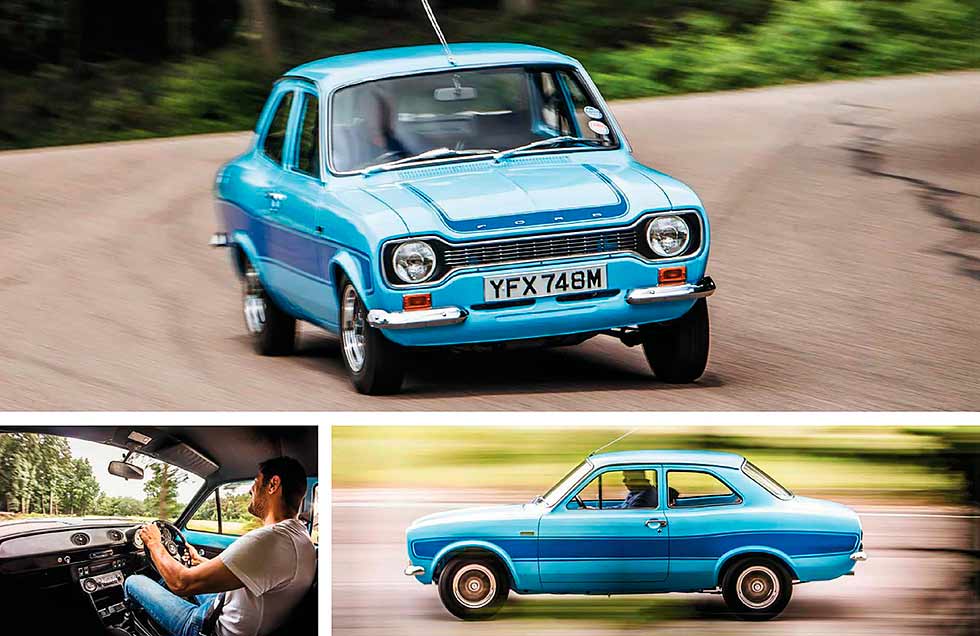
Ford’s feisty RS2000 MkI must be the epitome of a sensible family car transformed into a performance plaything.
£10,000 ‘I’m slightly biased because I used to own a BMW E30 325i Sport,’ admits Smith. ‘I loved how refined it was and how everything worked – it had a real sense of build quality. It represents a real compromise between a classic and a modern car and was very desirable in its day. The mechanicals are straightforward and little goes wrong with them – but even if it does it’s usually fixable. People love driving them, so most have Star Trek miles, but it’s a lot of car for the money if you can find a good one.’
£50,000 Smith’s pick here is the Ferrari 348 tb. ‘While it’s not the most amazing Ferrari to drive it’s certainly not a bad car. I have an old Car magazine with a comparison test between a 348, Porsche 928 S4, Honda NSX and Lotus Esprit Turbo and the Ferrari won hands-down.’ Smith advises opting for the tb because it’s more rigid than the ts. ‘Prices of the 328 and 355 are more than double that of a good 348, but step from a 328 into a 348 and the increased grunt and refinement are obvious.’
£75,000 ‘The Alfa Romeo Giulia SS – perfect design, flawless styling and effortlessly beautiful,’ says Smith. ‘It’s also super-rare and very much of an era thanks to its clear Disco Volante concept cars inspiration. It looks like something out of The Jetsons. Both engines – 1300 and 1600 – are bulletproof and it’s a car you can really use thanks to the five-speed gearbox and disc brakes. When you drive one, you can see why Alfa Romeos of this era have developed such a following. I’d expect it to gradually creep over £100,000 in the long term.’
£100,000 At this price Smith suggests seeking out a Jaguar XK150 Drophead Coupé. ‘What else could you buy for £100k that gives you so much? You get an open-topped Fifties six-cylinder British sports car that’s eminently tunable and makes a great noise – even if it’s not particularly interesting in the corners. If you make logical comparisons its Aston Martin and Maserati competitors cost three or four times more, which in my opinion makes this low-volume Jaguar very undervalued.’
£100,000+ ‘I fell in love with the Maserati Sebring S1 I sold a few months ago. You’re unlikely to see another on the road. It’s subtle but if you put it next to an Aston Martin DB4 or DB5 the Sebring is always going to be viewed as the more interesting car – the thinking man’s choice. The engine has a beautiful race pedigree and the performance is comparable to a DB4 GT. There’s more than enough potential to double its value eventually – I’d buy one now if I had the money.’
‘I love the Maserati Sebring S1 – it’s the thinking man’s choice’
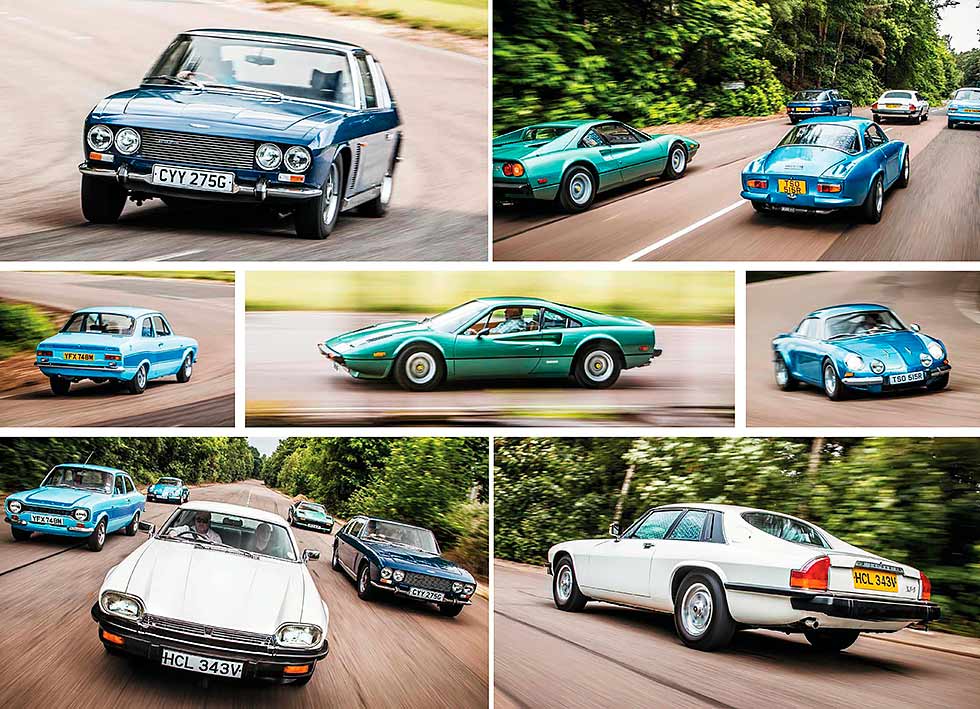
For £50k you’ll get a top-quality, totally sorted Interceptor. Dare to be different – shun Rosso Corsa and get yourself a green 308. Escort RS2000 MkI – good value at £25k and still a head-turner. Our experts’ very different takes on classics to buy now – cars of character and growth potential. Five cars guaranteed to spread a smile all the way across your face. You can enter lots of topnotch classic events if you opt for an Alpine A110. Go for a Seventies pre-HE XJ-S if you can find a decent one.
John Mayhead, Hagerty Insurance
Ex-army officer and committed Italian classic car enthusiast Mayhead is Hagerty Insurance’s online market editor. He’s also a regular contributor to The Sunday Times Driving as well as a number of other motoring publications.
£50,000 Those afflicted with snobbery can miss out on some of the best things in life. Take the Jensen Interceptor – it was a genuine Aston Martin rival in period but has languished in Aston’s shadow for years because it’s powered by a big American V8.
But what would you rather pay to have rebuilt – a mass-produced V8 or an in-house Newport Pagnell motor? Yet other similarly powered cross-continental amalgams – Facel Vega and Bizzarrini spring to mind – have been taken seriously for years, their lack of a truly thoroughbred engine consigned to historical prejudice.
It’s for this reason that John Mayhead reckons Interceptor values still have a long way to climb. ‘The four-wheel-drive Jensen FF has already increased significantly and I believe the Interceptor will continue its upwards trend in their wake. They really are great value when compared with other grand tourers.’
So which to go for? Mayhead has two suggestions, ‘The MkI for its sublime interior and the MkIII 7.2 SP for grunt.’ The MkI is hardly lacking in power – its 6276cc Chrysler V8 musters 325bhp – but you get a thumping 385bhp in Holley carburettor-fed Six Pack guise. Whichever way you go all that power is enveloped in a handsome Touring of Milan-designed body, here complemented by smart Rubery Owen pressed steel wheels. Get up close to the car and the huge curved glass hatchback – so controversial back in the Sixties – offsets the rest of the car’s angularity and lends it a squat stance that screams latent power.
Open the door and you can see why Mayhead recommends the early car – it’s a wonderful combination of burr walnut, Connolly leather, chrome dials, tactile flick switches and Jaeger dials. If traditional Sixties interiors are your thing, then this nigh-on perfect cabin transports you back to a time of unfiltered cigarettes, psychedelia and pirate radio ships.
Better still, this is a GT that really can carry four normal-sized adults – but do make sure the leather is in tip-top condition before you buy one because there’s more hide on that gargantuan back seat alone than on a Florence Knoll sofa and the cost of a re-trim will make a £6500-£9500 dent in your bank account.
The V8 ticks over with a lazy whubba-whubba exhaust note and its power delivery is pure Detroit muscle. There’s a huge amount of torque from low down in the rev range and you can feel the rear tyres biting as they lay down the power. It’s not a high-revving beast – it redlines at 5200rpm and peaks at just 4600rpm – but with instant access to its considerable clout it doesn’t need to be.
For such a big car its turning circle is surprisingly small, but unlike the planted FF you can feel the Interceptor’s front wheels start to lose grip when cornering hard and initial understeer will quickly turn to lurch oversteer; in truth the Interceptor is at its best when devouring long distances in a straight line. And while mid-teens real-life fuel economy isn’t as terrifying as legend suggests, its thirst will always be a topic of conversation. But my, does it do it with one big booming soundtrack.
Mayhead cautions against scrimping once you’ve decided to buy one. ‘Cheap Interceptors do still exist but restoration costs can be high,’ he warns. ‘For £50k you’ll get a top-quality, totally sorted car.’
£10,000 ‘Go for any Alfa Romeo with a V6 Busso engine,’ urges Mayhead. ‘It’s the word of the moment in Alfa circles. This cracking power unit is lauded as the last of Alfa’s truly free-revving engines and it helps that it was fitted to some of the marque’s best cars of the past 25 years. Ten thousand pounds will get you a middle-ranking Alfetta GTV6 or 156 GTA, or a cracking 147 GTA or GT with money to spare. With Giulia 105-series model values now up in the collectable leagues, this is where the Alfa enthusiasts are buying – expect demand to continue to increase.’
£25,000 ‘Front-engined Porsches are all the rage,’ says Mayhead. ‘We’ve already seen values of the 928 GTS and 944 Turbo go through the roof – the Hagerty price guide tracked the latter’s value as increasing by more than 25 per cent in the fourth quarter of 2015 alone.’ For that reason he tips the Porsche 928. ‘People have finally realised that they are superb driving machines with bombproof engineering and stylish interiors.
Plus they’re a bargain compared to their 911 brothers. £25k will buy you a cracking, low-mileage 928 S4 with a 5.0-litre engine and more than 300bhp.’
£75,000 ‘Hagerty has been saying that Maseratis look undervalued compared with other Italian sports car marques for some time, and the market now seems to agree,’ reports Mayhead. Values of Boras, Meraks and Ghiblis have all grown strongly in recent years and he reckons there’s not much left at the £75k price mark except the Maserati Mexico. ‘It’s a cracking grand tourer with a stylish Vignale body. For £75k you won’t get the best – but it’s enough for a good 4.7-litre car that’s likely to continue growing in value.’
£100,000 You may not have heard of Mayhead’s £100k pick but he believes the ASA 1000GT is a great investment. ‘Admittedly, they are hard to find but, when you do, you’ll have found yourself a jewel. This junior Ferrari looks every bit as beautiful as its prancing horse stablemates. The 1032cc sohc straightfour – although obviously smaller than the Ferrari equivalents – is a wonderful piece of engineering.’
£100,000+ Like Iain Tyrell, Mayhead is drawn to the Aston Martin V8, but unlike his fellow expert it’s a very specific model and puts his pick into our upper price bracket. ‘With Seventies and Eighties cars all the rage, the V8 has to be the Aston Martin of the moment.’ Yet it’s the Vantage Volante for him. ‘It ticks all the boxes for a good investment – top-quality manufacturer, low build numbers, superb design and lots of power. It also has all the right cultural references, including James Bond and – in Prince of Wales spec – the Royal Family.’
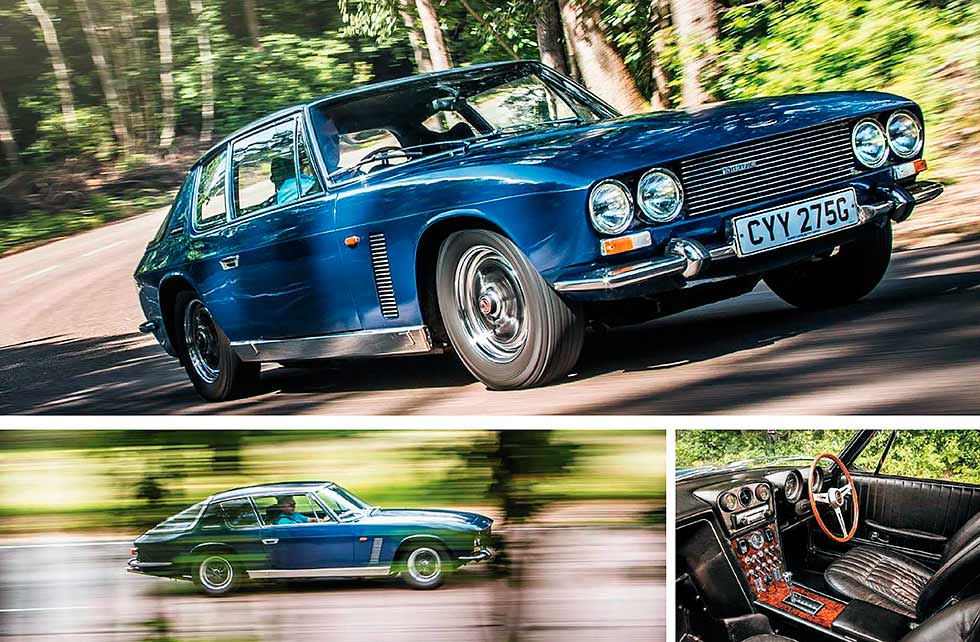
The Interceptor has languished too long in Aston Martin’s shadow – prices may well follow the FF up when they start to move again.
‘The Porsche 928 is a bargain compared to its 911 brothers’
Emanuele Collo, Kidston SA
Collo is Geneva-based boutique adviser Kidston’s business manager. His areas of expertise are post-war Italian and German cars, and his own Alfa Romeo Giulia GT Coupé and Porsche 911 Targas – 2.4 and 2.7 – reflect that.
£75,000 Jean Rédélé had already experienced some success with his A106 and A108 Alpines by 1962 but that year’s A110 cemented the company’s place in rallying folklore. As before, it had a lightweight glassfibre body allied to Renault running gear, with the four-cylinder engine located in its tail.
It was a slow burner, though, developed through myriad combinations of engine and suspension. It came of age during the early Seventies, devouring competitors from Fiat, Porsche, Ford and Citroën to record a 1-2-3 finish in the 1971 Monte Carlo Rally, before storming to the inaugural 1973 World Rally Championship – again, achieving the top three Monte positions.
It’s this history of achievement that makes the Renault Alpine A110 Emanuele Collo’s £75k choice. ‘You can do a lot of prestigious events in this car, including the Monte Carlo Historic,’ he says, ‘and all for the price of a basic Porsche 911. The Alpine competed at the highest level with the top-specification 911 S in period, but personally I think it’s more special, less common, and unlike the Porsche hasn’t been used by speculators to diversify their portfolios.’
You only realise how diminutive the Alpine is when you approach it – it really is the antithesis of a modern car – and its body’s purposeful stance is a riot of aggressive sweeps, scoops and flares. View it from behind and the negative rear camber provides a visual indicator of its considerable competition breeding.
This Spanish-built 1600SX has just joined Renault UK’s heritage fleet. It has the later Renault 16 TS aluminium cylinder block rather than the original cast-iron unit, with a pair of twin-choke Weber 45 carburettors and a heady 138bhp – all in a car weighing just 725kg. For a six-plus-footer like me, getting into the tight cabin entails a feet-first manoeuvre. The seat is particularly supportive, but the driving position is sheer comedy with the driver sitting diagonally, feet heavily offset in the footwell.
‘I like the driving position – it’s pure fun, and wraps around you,’ says Collo. ‘The materials aren’t state-of-the-art but the overall package is very special. If you sit in one you just want to drive it.’ Which is what I’m about to do. The whole tub reverberates when I fire it up and blip the throttle, the twin Webers eliciting a glorious bellow that tightens to a sharp bark – even at low speeds.
The first few turns of the steering wheel reveal a remarkable level of feel. This car goes exactly where you want it to go, it gets better the harder you press on, and the balance through tight corners transmits the same feeling to your core as riding on a rollercoaster.
This really is a phenomenal piece of kit and it’s easy to see how it enabled Renault to achieve such rallying success. A110s do have a reputation for being tricky to handle on the limit – it’s a car that demands respect until you learn its limits which, thankfully, are well out of reach on public roads.
Collo sums it up neatly. ‘With its rally-winning heritage, those looks and fantastic driving experience this is the sort of car you just want to get into, drive and forget about the world.’
£10,000 ‘I lusted after the BMW E39 M5 when it was new,’ recalls Collo. ‘It’s one of BMW’s most beautiful saloons. The V8 engine is gorgeously creamy in its power delivery and it’s a very analogue car – manual gearbox, rear-wheel drive, normally aspirated – which is something you don’t often find any more. If you get lucky and find a good car then I think their values have a way to go before they peak.’
£25,000 At £25k Collo opts for another German offering, the Audi RS2. ‘It was quite something else when it came out – nobody could quite believe it. It has a timeless shape, one of the best soundtracks ever and gives the enthusiast driver a lot of pleasure.’
However, you may need to be patient because, as with so many great classics, finding a decent one is the big challenge. ‘Many that come on the market aren’t very good, so don’t discount highmileage cars if they’ve been well looked after. There are a lot of people out there willing to pay – perhaps over the odds – for an unmolested one.’
£50,000 Collo recalls pointing out a Lancia Delta Integrale Evo 2 in an understated colour to a friend who asked if it was a Dacia. ‘I find it highly amusing that some people simply have no idea what it is. It’s a legend on wheels – the car that established the hardcore hatchback, with power delivery that’s far from being politically correct. Get a well-sorted one on the right piece of road and it will perform like a go-kart. The Integrale is prized by the generation that is just getting its money now – go for a special series or one of the late cars like the Evo 2.’
£100,000 ‘You’ll spend much more than this if you want the Italian equivalent of a Jaguar E-type S1 roadster – and even then it probably won’t be as good-looking,’ says Collo. ‘£100k may not buy the best S1 roadster but it should unearth a selection of good usable cars in the classifieds. If you’re willing to wait for the right one and to make it perfect over time there will always be a market when you come to sell.’
£100,000+ Collo reckons you’d have to pay much, much more if you wanted a Bugatti, Porsche or Ferrari with a similar place in its maker’s history to the Alfa Romeo Giulia Sprint GTA. ‘It’s one of the most successful GT cars ever built,’ he says. ‘In terms of brand it’s difficult to beat Alfa Romeo; and this one is nimble, tactile and super-direct with a fantastic engine and gearbox. There are so many cars that are overrated – but buy a GTA and you can celebrate a car with fantastic ingredients and a position at the top of motor sport.’
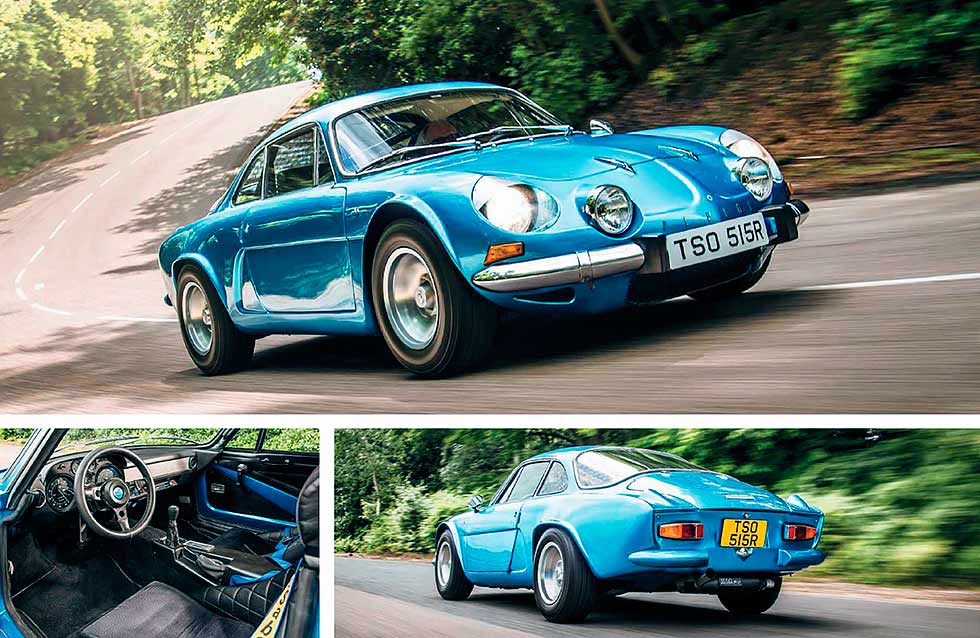
A riot of crazy curves clothes a rally legend. Get an Alpine 110 if you’re up to the challenge of taming it.
‘A well-sorted Delta Integrale will perform like a go-kart’
James Knight, Bonhams
Knight is group director of Bonhams’ motoring department and a familiar face to those who follow the high-end classic car auction world. He owns a 1954 Austin-Healey 100 and is a member of several motoring clubs.
£100,000 ‘I’ve always thought the Ferrari 308 was beautiful,’ says Knight. ‘It’s the little sister compared to the Ferrari 512 BB and although I’ve long thought that BBs are undervalued I feel the 308 is easier to drive and maintain and is generally a nicer car to live with. Let’s face it, who is going to push a BB to its limits? Oh, and did I mention that it looks a bit like a Ferrari 288 GTO?’
Those looks emerged from the rather awkward angles of the Bertone-styled 308 GT4, a car that had the almost impossible task of following in the Ferrari 246 Dino’s footsteps.
At launch in 1975 Pininfarina’s curvaceous rethink certainly hit the spot. And no matter how much you may covet red Italian sports cars, David Foster’s Verde Pino Metallizzato example is rather like seeing a 308 for the first time. The colour draws the eye to every flourish of designer Leonardo Fioravanti’s pen. It’s low and sweeping in profile with no excess adornment, while the rear-three-quarter view blends art with aggression. Here in Berlinetta form the roofline also remains pleasingly unbroken – it’s a struggle to drag your gaze away from this Ferrari.
This early car’s 90-degree 2926cc quad-cam V8 sits transversely, fed by four Weber DCNF carburettors – it’s the most powerful of the 308s and definitely the best-sounding. Unlike most Ferraris the engine bay isn’t detailed to within an inch of its mountings because, with just over 81,000 miles on the clock, this one is a real driver’s car.
Pull on the discreet handle, open the door and lower yourself into the cabin. It’s a very appealing environment, the tan leather contrasting with the exterior and the black interior detailing. Like the Dino 246, you feel as if you’re sitting in a racing car for the road with a compact instrument binnacle straight ahead and a three-spoke leather steering wheel and long gearlever all perfectly placed.
It’s immediately clear that this car’s V8 is a very different beast from the big Jensen’s US lump. There’s a gamut of belt-driven camshaft and valve-gear chatter at idle, but it hardens the second you nail the throttle and the tachometer spins freely through to 7000rpm, accompanied by a manic strings solo and thunderous percussion. The gearbox responds best to measured responses and the sharp steering is second only to the Alpine A110S.
It’s not especially quick – 0-60mph take 6.6 seconds. But as Knight’s already intimated, it offers infinitely more real-world usable performance than its bonkers BB big brother. Viewed as a complete package, this is a Ferrari that’s very easy to live with and one that will always have you nipping out for one more drive just to hear that sonorous V8 work its magic.
‘The lineage of these cars went through any number of phases,’ explains Knight. ‘The bodies were initially constructed of glassfibre [Vetroresina] and the engines were carburettor-fed, then they were fuel-injected [GTB/Si], and then they were offered with four valves per cylinder [Quattrovalvole].
‘Much of the Ferrari market is a numbers game and you’ll be lucky to find a seller willing to part with a rarer Vetroresina for this sort of money. Plenty of other variants can be bought sub-£100k but personally I’d go for an early carburettor car with a steel body.’ Just like this one, then.
£10,000 ‘I used to own a Citroën 2CV in the Eighties and I’ve never loved – or loathed – a car quite so much,’ reminisces Knight. ‘It was great fun when it was working but could be a recalcitrant starter in the damp. I lost count of the number of times I wore the battery down and then had to hand-crank it – yes, it had a starting handle.’ All that said, Knight reckons that most of the many people who dismiss the 2CV out of hand have never owned or driven one. ‘It put a smile on everyone’s faces – including mine – wherever I went. There aren’t many left now and my advice is to go for as early a car as you can.’
£25,000 ‘I remember a senior colleague borrowing his mate’s BMW M635 CSi E24 in the Eighties and being driven up the M40 on a valuation. I won’t tell you what speed we got up to, but it was the fastest I’d been in my life while still being connected to planet earth. I remember thinking it was the most beautiful and purposeful-looking thing on the road and they still look great today. And best of all, it has essentially the same engine as the BMW M1 E26 supercar.’
£50,000 ‘I kick myself whenever I remember that Derby Bentleys were no more than £15k-£20k for many years, though today you should find one in good order for less than £50k.’ Knight suggests the Bentley 3.5-Litre Sports Saloon can seem large in photos but looks smaller up close and better for it. He adds, ‘You only go so fast in a Derby Bentley but it’s certainly fast enough – anyway, speed isn’t the point with these cars.’
£75,000 ‘Why have the Jaguar XK140, XK150 and Jaguar E-type and Aston Martin DB2 and DB2/4, and even the Austin-Healey 100/3000, shown such rapid growth in the past decade when the Jaguar XK120 roadster hasn’t?’ asks Knight. ‘I know it can be a squeeze to get into but we’re talking about a car with sublime looks and one of the best powerplants around and whose racing sibling was the Jaguar C-type. The simple fact is the XK120 roadster has languished where other comparable cars have grown in value – and that doesn’t seem right.’
£100,000+ ‘The Austin-Healey 100S was built specifically for sports racing and competed at all the blue riband international events in period,’ says Knight. ‘It shared the grid with the best Ferrari, Lancia, Maserati, Mercedes-Benz, Aston Martin and Jaguar could offer and is eligible for all the great historic events today. I’m not naive enough to think they ought to be worth the same as the aforementioned exotica but I feel there is too much of a gap. And you’ll smile at the end of the season when you add up how much it has cost to prepare, run and rebuild compared to the others.’
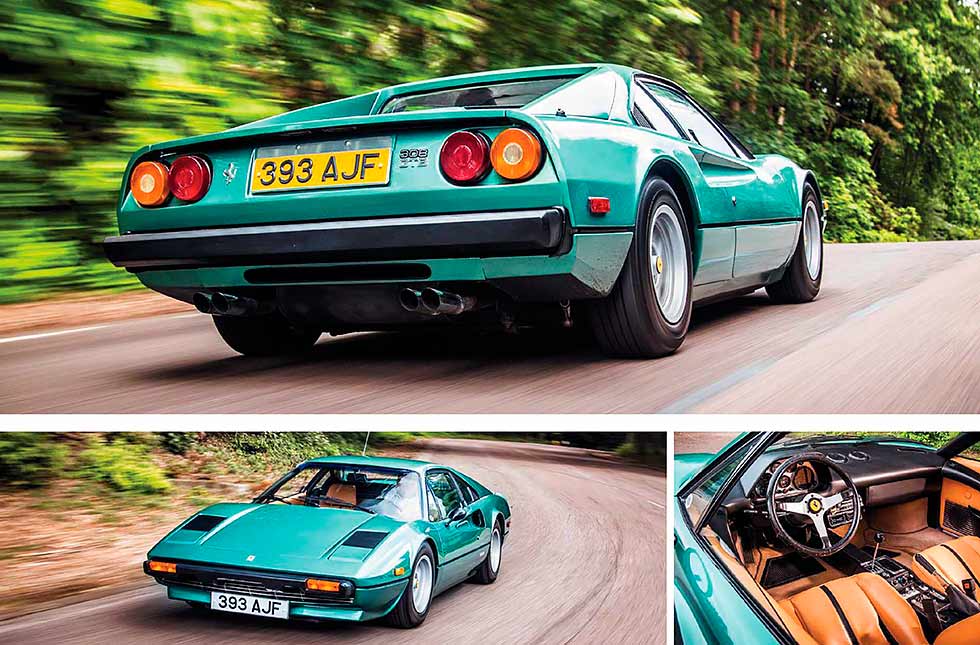
Ferraris are the default setting for investors – the 308 GTB is also huge fun to drive.
‘XK120 prices have languished and that doesn’t seem right’
‘It’s the real enthusiasts who make the market sustainable‘
Verdict
While our experts agree that the market has cooled in recent months, each was able to tip half a dozen cars across our price categories that have scope for growth. They may make a living out of the market but they are all incurable petrolheads who recommend driving and aesthetic pleasure over financial gain.
The Jaguar XJ-S, Ford Escort RS2000 and Jensen Interceptor have the most room for steady growth, while the Alpine lends instant access to top-end driving events, and the 308 the kudos and driving pleasure associated with the most famous badge in the industry.
Evaluating which cars are going to start climbing is an art in itself, but getting out and driving them is infinitely better. Of our gathered cars, the choice is a difficult one. For a man who invariably gravitates towards homologation specials, the Alpine and RS2000 offer thrills aplenty – time spent with either is a bona-fide blast.
I’d never tire of the Interceptor’s torque-fest – barrelling along in this brute’s elegant cabin is a hoot. The 308 has a more sophisticated driving experience than you might expect and, as a less hectic accompaniment to the road rally boys, it suits my tastes perfectly. Most unexpected of all is the car I’d choose – the XJ-S. It’s always been a silky-smooth performer, but time’s been kind to the visual package and it’s mellowing into the car Jaguar always expected it to be. Surprisingly, it appears that the name’s Templar… Simon Templar.

Thanks to: Cheshire Classic Cars (cheshireclassiccars.co.uk), Kidston SA (kidston.com), Bonhams (bonhams.com), Silverstone Auctions (silverstoneauctions.com), Hagerty Insurance (hagertyinsurance.co.uk), Rejen (jensenparts.co.uk), David Brooks, Ford AVO Owners’ Club (avoclub.co.uk), Ford RS Owners’ Club (rsownersclub.co.uk), Charles Porter, David Foster, Renault UK (renault.co.uk), Jeremy Townsend, Jensen Owners’ Club (joc.org.uk), Tim Clark.





